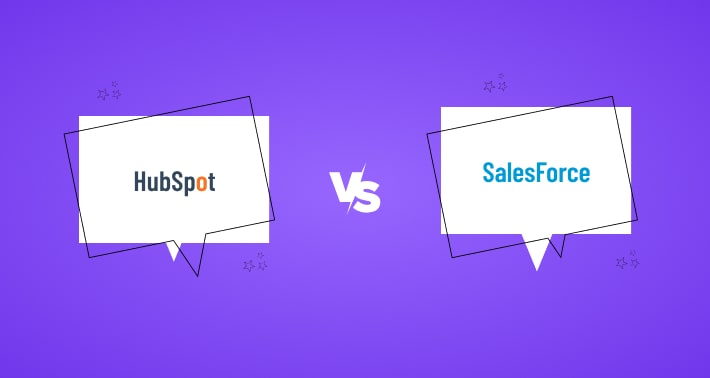HubSpot vs. Salesforce: In-Depth Comparison of Features & Pricing

After going through extensive research, it has been seen that HubSpot is more profitable than Salesforce in terms of marketing and sales. Furthermore, Hubspot and Salesforce are the best CMRs in recent times, especially for small businesses. People might find the distinctions between hubspot vs Salesforce, but they always give thanks to both of them for robust free plans.
After estimating that this has been that Salesforce is more valuable than HubSpot, especially for consumer service, I find it intriguing. Do you know why? After all, it offers multiple convenient communication media to reach many customers.
Above all, people recently used HubSpot for their startup businesses more than Salesforce. Not only that, but they also got results for this. Here are the differences between hubspot vs Salesforce.
Let’s Talk About HubSpot vs SalesForce

In recent times, both HubSpot and Salesforce have been the most renowned platforms across the entire industry. If you are trying to organize projects or if you want to manage customer relationships, HubSpot or SalesForce would be the most convenient. Below, I am going to discuss the differences between HubSpot and SalesForce.
1) Sales Reporting & Forecasting
HubSpot has advanced sales reporting along with forecasting. But HubSpot requires an upgraded paid plan. Meanwhile, SalesForce has highly advanced sales reporting and forecasting capabilities. Aside from that, some basic reporting features are available in the baseline plans.
2) Marketing Features
When it comes to marketing features, there is an extensive rate of marketing features available, which you will get for free, as well as Starter plans for HubSpot. On the other hand, extensive marketing automation features are available in the separate marketing package for SalesForce.
3) Customizations
Does Customization in HubSpot work better? In this case, HubSpot’s customization workflows and automation, like Javascript and Python coding, are quite better in terms of workflows.
On the other side, SalesForce has highly customizable coding in terms of coding capabilities.
4) Ease Of Use
HubSpot is much easier to use. HubSpot has step-by-step guidance, more incorporated navigation, and a dashboard. On the other hand, SalesForce also has a strong onboarding with a demo-like account. After all, this platform initially needed to be more intuitive.
5) Pricing
HubSpot has an extensive range of free plans, including a free CRM, baseline features, and so on. This works like pipedrive. Aside from that, HubSpot plans include specific product bundles and pricing packages that the user can scale and customize. On the other hand, the free plan of HubSpot starts from $20 monthly to $1500 per month.
SalesForce charges start per user every month in an affordable manner. In this case, you can get multiple features that come as standalone applications accessible by purchase. After all, plans are highly segregated. Similarly, the functionality of SalesForce can be much more expensive. In this case, essentials start from $25 monthly to $330 per user.
6) AI Features
Does HubSpot have well-incorporated AI features? After all, HubSpot is even lower at pricing tiers regarding AI, predictive analytics, and other smart suggestions.
On the other hand, SalesForce’s AI functionality comes from the proprietary Einstein tool, which offers multiple generative software tools. Aside from that, workflow automation, smart insights, predictive analytics, and so on are not integrated conveniently. After all, this scales the features by plan.
Let’s Talk About Salesforce Marketing Cloud Engagement
At first, the prices in the SalesForce Marketing Cloud are jarring. Above all, the marketing cloud is packed with many automation features. Below, I am going to discuss SalesForce marketing cloud engagement.
The marketing cloud engagement can easily handle operations in a streamlined and aligned way. Still, this doesn’t change how expensive these plans are. You can clarify this by aiming at a larger business than small startups.
Thankfully, these plans don’t have any minimum user requirements either. But you will be paid a lot at the prices regardless of anything. Here are the pricing plans of Marketing Cloud engagement such as:
SalesForce plan for pro is $1250 per month. On the other hand, the SalesForce plan for corporate is $ 4,200 per month. These plans will be valid for up to 30 days.
The Best Features Of Salesforce And HubSpot
HubSpot and SalesForce both are considered as CRM options which are high-end. In this case, they offer many features for myriad purposes. Below, I am going to discuss the best parts of SalesForce and HubSpot.
1) Marketing Features
When this comes to the specific features of SalesForce marketing, it means honing even closer. After all, HubSpot Marketing Hub is a top choice, especially for CRM for marketing. In this case you have to give thanks to the vast array of marketing channels including social media, email, paid content.
On the other hand, SalesForce offers very essential options for several channels, such as social, content, and paid, which is why HubSpot is one of the most advantageous.
In addition, HubSpot offers more, especially regarding customer support, onboarding new users, and better customer support when you go with a problem. The marketing features of HubSpot alternatives are also quite convenient.
2) Service Features
SalesForce shines. In this case, the customer support CRM features are embedded continuously in the SalesForce Service Hub. After all, this provides more communication and ticketing channels than HubSpot.
While this is about customer service features, customer feedback functionality is important. Aside from that, CRM shouldn’t deter you. There are other features which you can make up more than this small oversight.
3) Sales Features
In the SalesForce software tool, you will experience the most popular CRM features. Although HubSpot has its options, especially for your business, HubSpot beats SalesForce on multiple features like lead capture and lead conversion.
In Conclusion
I have discussed HubSpot vs. Salesforce above in this article. SalesForce is a robust CRM with a lot of features.
A large company is behind this in terms of providing unparalleled customer support, especially for users, which makes this perfect even for larger companies. On the other side, HubSpot aims to build smaller businesses into larger ones. After all the features of these platforms, even for beginners. I hope you find this article helpful. If you have any questions, comment below!
Learn More About:
























